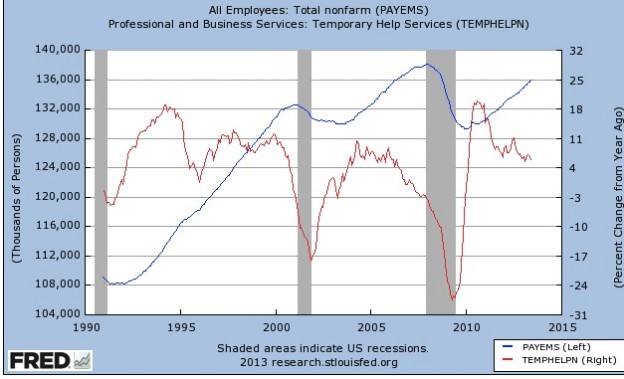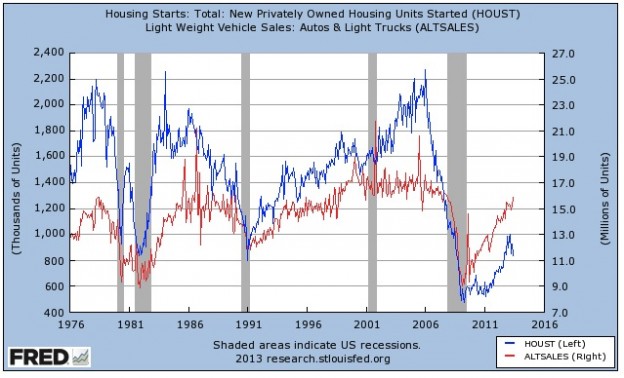I’ve done hundreds of posts over the past few years on the employment situation and how simple it really is to predict the direction it is heading. One need only follow three things (in order):
1- temp employment
2- housing starts (both SF and MF)
3- auto sales
Those three data points will give you overall demand for employment (temp help) and the underlying economics drivers of it (auto and housing being 2 largest employment industries both directly and indirectly). Now, none will tell you whether we will see 100k or 125k in any given month and in reality for long term investors, it does not really matter. Weekly data is wholly meaningless when it is announced due to the huge revisions on it and monthly data while better is itself really volatile. It is the general trend that matters and the above three indicators will tell you what that is before the official announcement.
Temp help dives well before total employment and the start of a recession (and turns positive as we exit and before overall employment does):
The same happens with both auto and housing, they go into decline both before aggregate employment and the resulting recession. Not: both are volatile series so again we must ignore weekly data absolutely and put monthly data into the larger picture:
Currently both auto and housing are in strong uptrends and temp help is near its highest level since 2007. From that expect continued positive employment trends…..
“Davison” submits:
The demand for new employees is reflected in the American Staffing Association’s ASA Staffing (Temp) Index. The history of this index is that the direction of the trend has been a good leading indicator for changes in the Establishment and Household Surveys produced by the Bureau of Labor. The ASA Index for contract employees, reported weekly, hit a new high of 95. Hiring trends have relied more and more over the years on a period of temporary employment to assess an employee’s corporate/cultural fit and skill set prior to offering full time employment. This can reduce the risks of hiring the “wrong” employee for a corporation’s needs.
The historical patterns show that temporary employment leads to higher full employment. The argument currently is that Obamacare has forced companies to hire temporary employees preferentially to avoid the issues perceive with the new healthcare law. The data is not historically different from the past and if this is truly an issue it has not yet reflected a change in the long term averages.
I take higher temporary employment as indicating higher full time employment in the months ahead as this is backed by economic history. The hiring trends remain positive and we have all-time highs in Personal Income. The economic data continues to act as within the range of what one could expect in a typical recovery.
Today:
ROSELAND, N.J. – July 31, 2013 – Private-sector employment increased by 200,000 jobs from
June to July, according to the July ADP National Employment Report®. Broadly distributed to the public each month, free of charge, the ADP National Employment Report is produced by ADP®, a leading provider of human capital management solutions, in collaboration with Moody’s Analytics. The report is derived from ADP’s actual payroll data and measures the change in total nonfarm private employment each month on a seasonally-adjusted basis. June’s job gain was revised upward from 188,000 to 198,000.


